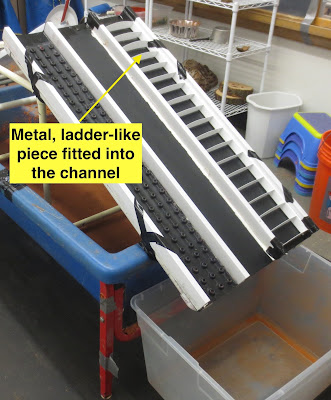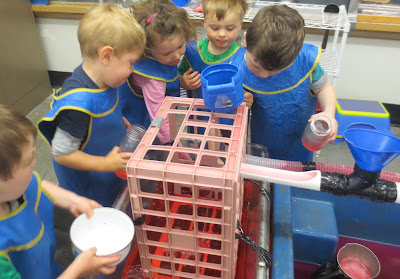Don't ask me what it is because I do not know what it is. I got it from a dumpster and it looked too intriguing to pass up.
Fast forward one month and I brought back the channel apparatus with two new additions to the channels.
The channel on the left has a gutter sponge. It is used in gutters to let the water through, but nothing else. The gutter sponge I found one day just looking through the hardware store. When I saw it, I immediately thought of the channel board. In the middle is a beautiful piece of tree bark I found on a walk with my grandson down by the Mississippi River. Again, when I saw it, I immediately thought of the channel board. The channel on the left contains DRICORE squares which are screwed and glued in place so they did not change.
In the channel with the DRICORE squares there is a ribbed tube taped to the side of the channel. That tube is attached to a large funnel that is taped to the top of a crate.
The crate is set on a brown planter tray that is taped over a second water table. The planter tray has a whole in the bottom so if water is poured or spills into it, the water empties right back into the small table.
This picture also shows the frame onto which the channel board is taped to give it the requisite incline. The frame is made from PVC pipe and is open enough for the children to access the water in the blue water table.
How high is the funnel off the ground? It is high enough so the children need a stool to reach it and, even then, need good tippy-toe trunk extension to pour the water into the funnel.
Here is the whole setup from a different perspective. This perspective also shows the black tub into which the water falls off the channel board.
I would be lying if I said I was not disappointed in the two new additions to the channel board. For the gutter sponge, the water went quickly through with a slight delay appearing from underneath the sponge at the end. The slight delay did allow the children to make observations about the water flow, but rarely held their interest for long. The same was true for the bark. I actually thought that the water would flow through those beautiful striations of the bark like a babbling stream. Instead, the water, for the most part, flowed right under the bark into the black tub.
One feature of the installation more than made up for my disappointment. The funnel and tube became a focal point for multiple investigations into water flow. Here is one example. The child in the video below first experiments with what happens to the water when he pours it onto the gutter sponge. Satisfied with what he has observed, he moves to the channel with the tube and wonders aloud what happens to water in that channel. He goes to the other end of the table to pour water into the funnel. He trots quickly around to see what he hopes is water coming out of the tube down the channel. When he doesn't see any water, he starts to trace the tube back to the funnel. He notices that water has pooled in a bend in the tube. He first shakes the tube a little and says that the water stopped. Then he lifts the tube up and watches as the water starts moving in the tube. He follows the water and sees it exit the tube into the channel. He feels pretty good about his discovery and expresses it with an understated "whoa."
Investigating water flow from Thomas Bedard on Vimeo.
At the end, he redoubles his efforts and lifts the tube as high as he can so he empties the tube completely. Then he starts all over again to reaffirm the results of his experiment.
Adults take note. Don't ever sell the children short. Leave it to the them to find the most compelling feature of an apparatus for their own investigations.






















